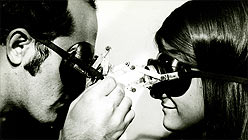I’ll be blunt: with regards to inspiring sheer visual awe, most of the pieces in SFMOMA’s The Art of Participation: 1950 to Now don’t hold up. This is particularly true when they are placed next to the marvels of Martin Puryear, or to Felix González-Torres’s Untitled (Golden) — a gold, beaded curtain that performs as an imposing and sensuous threshold to the exhibit Passageworks — both of which are also currently on view at SFMOMA.
This shouldn’t come as a surprise, however. Most of the works in the exhibition set out to intentionally complicate what at some point in the mid-20th century was decided to be an overly simple relationship: that of the viewer and the art object. It is from this discourse that we inherit phrases like audience complicity, social sculpture, relational aesthetics, and art as open work. So it’s to be expected that many of the art objects in this exhibition play second-fiddle to our interactions with them, if there is an object present to begin with.
It’s not a sneak attack, exactly. Like it or not (and some people really don’t like it), the variety of art today deemed as “participatory,” has long been folded into the art historical canon, and one of the intentions of The Art of Participation is to present a genealogy of sorts, revealing the historical antecedents of a new generation of artists whose works employ similar concepts and strategies, although often through different technologies. More broadly speaking, it’s a look at analogue and digital notions of interactivity, nodes, and participation — before and after the rise of the internet.
The curatorial staff has chosen John Cage’s 4’33” (1952) as a point of genesis, and the logic is easy enough to follow. Think about it: a man sits down at a piano in the middle of an urban setting and what follows is four minutes and thirty-three seconds of silence (see YouTube video here). A piece that invites you to listen to yourself listening. The piano (closed and untouchable) and the sheet music (blank) are on display, as well as a video of several different performances, all forming the centerpiece to the first room of the exhibition — both a chronological and a physical precursor to virtually all the other works on view.
There’s a lot of video documentation, of course, including two performances of Yoko Ono’s Cut Piece (1965/2003), in which the artist invites the audience to cut the clothes off her body. The decision to display both performances simultaneously is a smart one; the small differences in the way each audience handles the artist’s request really change the tone of the piece. Also worth stopping to watch is a re-installment of Kit Galloway and Sherrie Rabinowitz’s Hole-in-Space (1980), using original footage. Imagine, in 1980, a live video feed set up between crowds in New York and Los Angeles, before the availability of video chats. People get VERY excited.


